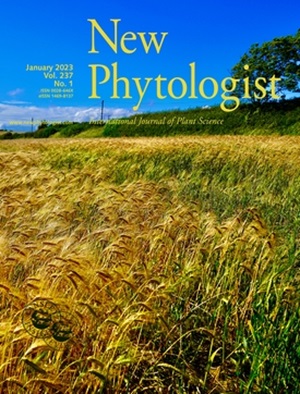Proper activity of the age-dependent miR156 is required for leaf heteroblasty and extrafloral nectary development in Passiflora spp.
IF 8.3
1区 生物学
Q1 PLANT SCIENCES
引用次数: 0
Abstract
- Passion flower extrafloral nectaries (EFNs) protrude from leaves and facilitate mutualistic interactions with insects; however, how age cues control EFN growth remains poorly understood.
- Here, we examined leaf and EFN morphology and development of two Passiflora species with distinct leaf shapes, and compared the phenotype of these to transgenics with manipulated activity of the age-dependent miR156, which targets several SQUAMOSA PROMOTER-BINDING PROTEIN-LIKE (SPL) transcription factors.
- Low levels of miR156 correlated with leaf maturation and EFN formation in Passiflora edulis and P. cincinnata. Accordingly, manipulating miR156 activity affected leaf heteroblasty and EFN development. miR156-overexpressing leaves exhibited less abundant and tiny EFNs in both Passiflora species. EFN abundance remained mostly unchanged when miR156 activity was reduced, but it led to larger EFNs in P. cincinnata. Transcriptome analysis of young leaf primordia revealed that miR156-targeted SPLs may be required to properly express leaf and EFN-associated genes. Importantly, altered miR156 activity impacted sugar profiles of the nectar and modified ecological relationships between EFNs and ants.
- Our work provides evidence that the miR156/SPL module indirectly regulates EFN development in an age-dependent manner and that the EFN development program is closely associated with the heteroblastic developmental program of the EFN-bearing leaves.
年龄依赖性miR156的适当活性是西番莲叶片异型发育和花外蜜腺发育所必需的。
西番莲花的花外蜜腺(EFNs)从叶子中伸出,促进与昆虫的相互作用;然而,年龄线索如何控制EFN的生长仍然知之甚少。在这里,我们研究了两种具有不同叶片形状的西番莲的叶片和EFN形态和发育,并将这些表型与转基因进行了比较,这些转基因具有操纵年龄依赖性miR156的活性,其靶向几种SQUAMOSA启动子结合蛋白样(SPL)转录因子。低水平的miR156与西番莲和辛辛那提的叶片成熟和EFN形成相关。因此,调控miR156活性会影响叶片的异源发育和EFN的发育。mir156过表达叶片中efn的数量较少,且较小。当miR156活性降低时,EFN丰度基本保持不变,但它会导致辛辛那提麻的EFN变大。幼叶原基转录组分析显示,mir156靶向的SPLs可能需要正确表达叶片和efn相关基因。重要的是,miR156活性的改变影响了花蜜的糖谱,并改变了efn与蚂蚁之间的生态关系。我们的工作提供了证据,证明miR156/SPL模块以年龄依赖的方式间接调节EFN的发育,并且EFN的发育程序与EFN叶片的异母发育程序密切相关。
本文章由计算机程序翻译,如有差异,请以英文原文为准。
求助全文
约1分钟内获得全文
求助全文
来源期刊

New Phytologist
生物-植物科学
自引率
5.30%
发文量
728
期刊介绍:
New Phytologist is an international electronic journal published 24 times a year. It is owned by the New Phytologist Foundation, a non-profit-making charitable organization dedicated to promoting plant science. The journal publishes excellent, novel, rigorous, and timely research and scholarship in plant science and its applications. The articles cover topics in five sections: Physiology & Development, Environment, Interaction, Evolution, and Transformative Plant Biotechnology. These sections encompass intracellular processes, global environmental change, and encourage cross-disciplinary approaches. The journal recognizes the use of techniques from molecular and cell biology, functional genomics, modeling, and system-based approaches in plant science. Abstracting and Indexing Information for New Phytologist includes Academic Search, AgBiotech News & Information, Agroforestry Abstracts, Biochemistry & Biophysics Citation Index, Botanical Pesticides, CAB Abstracts®, Environment Index, Global Health, and Plant Breeding Abstracts, and others.
 求助内容:
求助内容: 应助结果提醒方式:
应助结果提醒方式:


